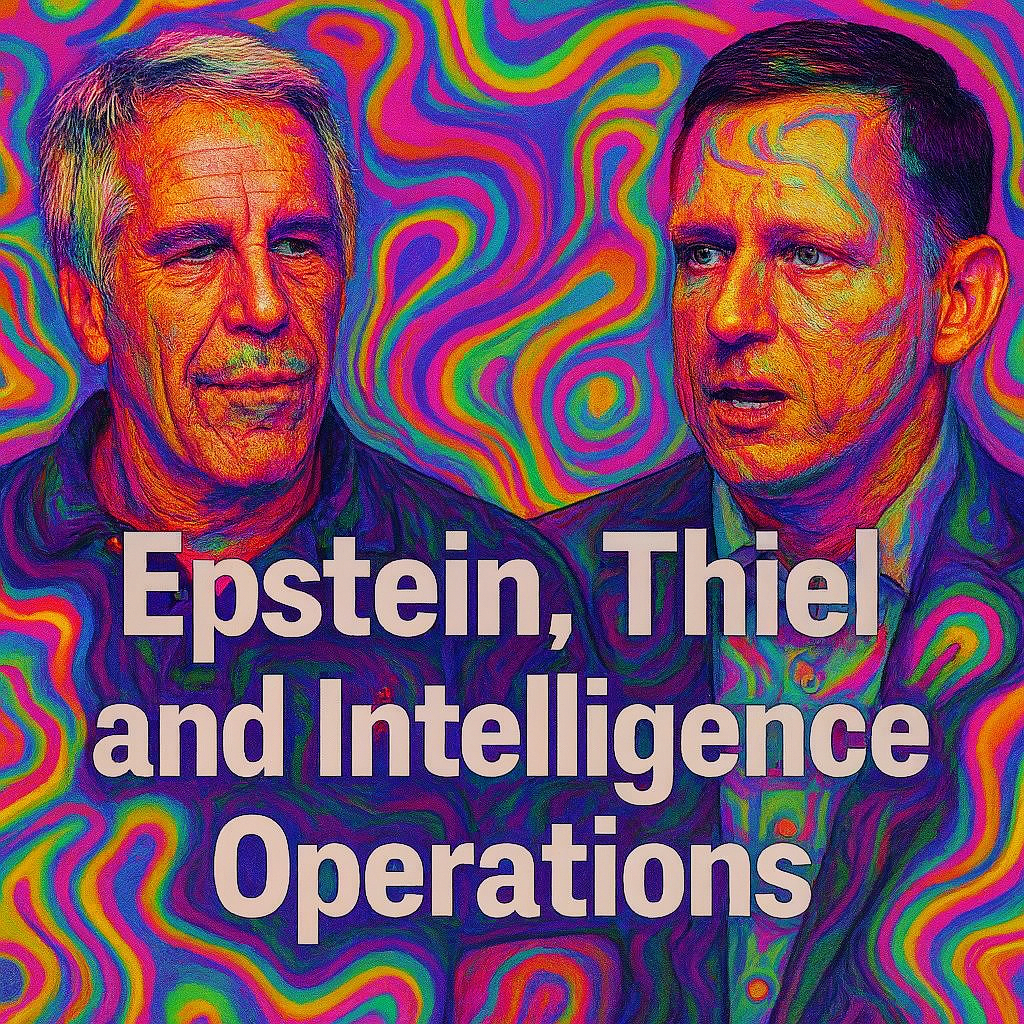“Secrets are like a psychic poison.”
– David Lynch

Some stories don’t end. They just get quiet.
Jeffrey Epstein’s death was supposed to be a full stop. A scandal contained. But if you follow the money—and the contracts—you start to see the shape of something still moving.
What Epstein built with charm and threats, others rebuilt with funding rounds and code.
⸻
the early link: thiel and epstein
In 2014, Epstein’s calendar showed something new: meetings with Peter Thiel.
By 2015, Reid Hoffman was hosting dinners where both men were present—alongside other tech elites. Epstein wasn’t being hidden. He was being reabsorbed.
That same year, Epstein put around $40 million into Valar Ventures, Thiel’s international investment fund. The connection wasn’t public, but it wasn’t a secret either—not to the people involved. By 2025, that investment had ballooned to $170 million, becoming the single largest disclosed asset in Epstein’s estate.
It’s worth asking: why did Thiel take the money?
And why did Epstein trust him with it?
⸻
palantir doesn’t need kompromat
Epstein used people. Palantir uses data.
The software doesn’t wait for a scandal. It builds profiles from public records, phone metadata, immigration files, financial transactions. It pulls in footage from license plate readers, facial recognition cameras, predictive algorithms from third parties.
Then it scores you.
The people using it don’t have to understand how it works. They just need to know what it tells them: who to watch, who to question, who to detain.
There’s no confrontation. No need for leverage. The assumption of risk is enough.
⸻
the mossad whisper, the machine upgrade

Former Israeli spy Ari Ben-Menashe once described Jeffrey Epstein as a honeytrap operator—not just a financier or predator, but an intelligence asset running operations for Mossad. His job was to compromise the powerful. Surveillance, seduction, leverage. He curated rooms where secrets were born, and then archived them.
But Mossad’s methods, like any intelligence apparatus, evolved.
What Epstein did with bodies and black books, Palantir now does with biometric data and artificial intelligence.
By 2024, Palantir had become a strategic partner of the Israeli Ministry of Defense, offering AI-driven surveillance, real-time urban threat modeling, and algorithmic targeting systems deployed in Gaza. The tools once wielded through seduction and silence now operate at machine scale—mapping populations, predicting behaviors, assigning scores.
Epstein’s influence network may have been dismantled.
But its function was preserved—and industrialized.
Palantir doesn’t need to film politicians behind closed doors.
It builds predictive dossiers on entire demographics.
It doesn’t use honeypots. It uses pattern recognition.
And while Epstein trafficked in elites, Palantir traffics in entire populations.
The pipeline is intact.
The method is upgraded.
The mission remains: extract control from knowledge, and call it national security.
⸻
embedded influence
Thiel didn’t stop at infrastructure. He helped build the personnel pipeline, too.
In 2016, he joined Trump’s transition team and helped install loyalists across key agencies: Homeland Security, the Pentagon, the intelligence community. After Trump left office, Thiel redirected his influence into campaigns—funding candidates like J.D. Vance and Blake Masters, who share his distrust of democratic systems and his fascination with centralized power.
He’s backed judges, secretaries of state, data analysts, education officials.
The goal doesn’t seem to be winning arguments.
It’s owning the systems that define what counts as truth.
⸻
this isn’t over
The people have changed. The tactics haven’t.
Epstein relied on intimacy, reputation, access.
Thiel’s model doesn’t require any of that. Just an entry point, a contract, and a feed of raw data.
That’s what makes this different.
You can’t dig your way out. You can’t go off the grid. The grid goes with you.
⸻
the transhumanist thread
The connection between Peter Thiel and Jeffrey Epstein doesn’t end with money or social circles—it dips into the speculative realm of transhumanism. That’s not just a sci-fi buzzword. It’s the ideological blueprint behind much of Silicon Valley’s quiet obsession with optimization: longevity, genetic enhancement, mind-uploading, surveillance-powered immortality.
Thiel has long invested in life-extension tech, parabiosis experiments, and AI-driven human enhancement projects. He’s not alone. These visions form the backbone of what some critics now call TESCREAL—a networked belief system blending transhumanism, effective altruism, rationalism, and longtermism. In this model, the world becomes a simulation to optimize, and those with power and data become its architects.
Epstein moved in the same speculative shadows. He funded scientists working on eugenics, gene editing, and neural decoding. He once spoke openly about seeding the future with his own DNA, dreaming of a post-human bloodline born not from myth but from math. He surrounded himself with the kinds of thinkers Thiel also admired—data priests, AI prophets, and longevity mystics.
Their philosophies met in the desire to escape death—and control memory.
Not by accident. In transhumanist logic, memory isn’t sacred. It’s storage. And if it’s just data, it can be deleted, rewritten, or encrypted. The blackmail machine isn’t just about power over people—it’s about power over selves, over narrative continuity. What happens when surveillance becomes a womb? When your future is engineered from predictive profiles and digital ghosts?
What happens when those running the machine believe they are post-human?
⸻
closing thoughts
It’s easy to talk about Epstein like a glitch. A one-off. A monster.
But the more you follow the trail, the more it looks like a prototype.
The systems that came after him—Thiel’s companies, the surveillance contracts, the behavioral modeling—they’re more efficient, more profitable, and way harder to see. You can’t arrest a spreadsheet. You can’t question a score.
We keep waiting for some big reveal. Some final truth. But maybe this is it.
Maybe this is what power looks like now. Not loud. Not obvious. Just… built in.
By the time you notice it, it’s already done what it came to do.
The memory war isn’t something we’ll win or lose in one moment.
It’s something we’re already inside.
So the real question is—
who gets to remember?
And who gets remembered wrong?
sources & further reading
📁 Epstein–Thiel–Valar Connections
• Business Insider – Epstein invested millions in Thiel’s Valar Ventures
• NYMag / Intelligencer – Reid Hoffman and the Epstein–Thiel Dinner
• CNBC – Epstein’s estate holds $170M in Valar Ventures stake
🛰️ Palantir, Surveillance, and Israel
• Haaretz – Palantir’s work with the Israeli military and Gaza targeting systems
• The Guardian – Palantir’s NHS and border surveillance contracts
• Intercept – Predictive policing and Palantir’s link to ICE
🧩 Intelligence Community Ties
• Ari Ben-Menashe Interview – Epstein’s ties to Mossad (archived)
• The Times of Israel – Epstein’s Israel connections explored
• The New Republic – The Mossad, Epstein, and the meaning of blackmail
📊 Thiel’s Political Influence & Government Placement
• The Verge – Thiel’s role in Trump’s transition
• ProPublica – Thiel-linked staffers placed across government
• New York Times – The rise of Thiel’s political network
📚 Deep Dives & Contextual Reading
• [Shoshana Zuboff – The Age of Surveillance Capitalism]
• [Cory Doctorow – How to Destroy Surveillance Capitalism (MIT Press)]
• [Anand Giridharadas – Winners Take All: The Elite Charade of Changing the World]

Leave a Reply